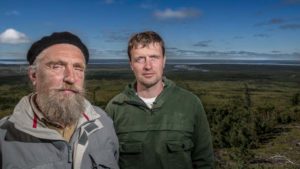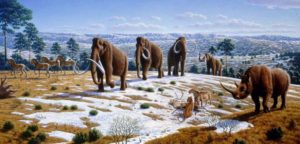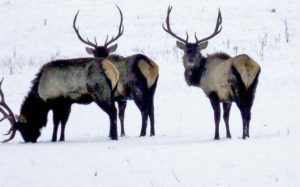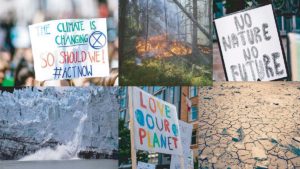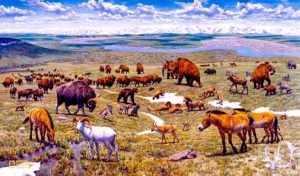I attended an amazing exhibition at the Guggenheim last summer called, Country Side, and one of the exhibits featured a place called Pleistocene Park located in Yakutia, Siberia. Country Side was about reimagining the uses of the countryside since vast populations are leaving the country for more urban environments, often leaving country sides bereft and economically unstable. The existence of this park is a perfect example of human creativity and ingenuity used to benefit all of humanity for future generations to come.
The two crazy scientists who are continuing this experiment.
Sergei Zimov, an ecologist started Pleistocene Park based on the philosophy that restoring the native animal and plant species from the ice age could stave off global warming. He asked for land in Yahutia, Siberia from the Russian government in 1988 (it’s not really populated nor in high demand, most acres sit vacant) and has been developing it using his own resources (with almost no other outside financial assistance), with his son, Nikita Zimov who joined him after finishing his university studies in mathematics.
Sergei is currently the director of the Northeast Science Station (1 of 3 largest arctic stations in the world) and Senior Research fellow of the Pacific Institute for Geography (an institute within the Far East Division of The Russian Academy of Sciences.). Until recently, he has been financing the application of his research on his own with salaries from these positions. In 2017, activists helped to organize crowd funding online to help them purchase and transport more wildlife for their park. Nikita is now director and spokesperson for the park and lectures extensively about their park project to save our planet from the catastrophic effects of global warming.
What is permafrost?
Permafrost is a permanently frozen layer below the earth’s surface. Found in arctic regions such as Alaska, Siberia and Canada. In order to reverse the damage caused by humans in Siberia, Sergei and Nikita are working to slow and eventually stop permafrost thawing by recreating the Pleistocene era ecosystem which includes reintroducing native animals and growing grasslands from the past.
What effect do the native animals and plant species have on the environment?
During the Pleistocene epoch (926 million-12,000 years ago), most of the Northern Hemisphere of the planet was covered in steppe grasslands and inhabited by millions of mammoths, bison, horses, deer, wolves, tigers and other animals. But as people began to populate the area the wildlife population gradually started to disappear (most likely from hunting them to extinction) causing a departure of the pastureland, turning it into forest and tundra. Today the remainder of the animals in the arctic is barely 1% of what it was in the late Pleistocene era.
The temperature of the permafrost is already 5 degrees celcius warmer than the average annual air temperature due to the formation in winter of a thick snow blanket that covers the soil and prevents deep freezing. By reverting the environment to be the pastureland it once was a millenia ago this effect can be prevented. If animals of the past came back to the environment, they would trample the winter snow as they were searching for food. The snow would then lose it’s heat insulating properties and the permafrost soil in water would freeze more than usual. This is how permafrost would be protected from melting. When the animals trample the snow, the temperature of the permafrost beneath the pastures is 4 degrees celcius lower.
What kinds of animals have Sergei and Nikita been adding to the park?
Although Sergei has been working on his park project since 1988 it became official in 1996 and now is a nonprofit. Only in the past few years has it really started flourishing with help from outside funding from activists. They have been bringing in lots of new animals thanks to crowd funding. The park covers around 5,830 acres of land of which 810 are fenced off and divided into 20-80 acres dedicated to grazing animals based on the condition of the soil. Almost 150 species of animals from the Pleistocene era are represented including: deer, Yakut horses, moose, bison, yaks, Kalmyk cows and sheep.
Why do we need it?
Sergei and Nikita are working to stop the thawing of permafrost in Siberia. Permafrost contains carbon that, if released into the air could at least equal the carbon production of the whole of the United States. There are frozen caves in Siberia some of which are 20,000 years old. They have created a huge storage of carbons. They’re not dangerous now because they are frozen, but with climate change, permafrost is getting warmer and warmer and in some part is already starting to thaw. When these roots thaw they will start releasing greenhouse gases like methane that will go into the atmosphere and further advance global warming. Sergei is one of the first geo-physicists to alert the world to the dangers of permafrost thawing and has been vocal about it for the past 20+ years.
If you haven’t noticed, there have been an unusual amount of raging wild fires in California, hurricanes, flooding in many parts of the world and unusually warm fall/winter weather in the Eastern United States. These are all caused by the effects of global warming.
Results so far
In Yukutia, Siberia although the ecological environment is fairly good by ecological standards (there are no factories there to polute the landscape), park workers say that the local plant life and soil are becoming more fertile as a direct result of reintroducing all the animals. This in turn is helping to build up carbon deposits in the soil, increasing it’s ability to reflect sunlight. For instance grasses are lighter in color than shrubs or forests and lighter surfaces tend to reflect more solar energy back into space lowering the temperature of the planet.
What is their vision? The ultimate goal of Pleistocene Park
Sergei and Nikita Zimov hope to create a sustainable and productive pastureland ecosystem in the Arctic long enough to affect the global climate. They are still a long way from this goal and are currently focusing on the process of selecting both animal and plant species. By following their current plan Sergei and Nikita aim to create sustainable animal and plant populations in select areas.
What you can do to help continue Pleistocene Park’s existence and in turn give our planet some love?
We all have more than enough of what we need clothes galore, electronics (ipads/tablets, games, smart phones), costume, jewelry, a million shoes. Instead of purchasing yet another material item for friends and family why not donate to a great cause (in the name of someone you love) to help further humanity and the planet we all live on? Put your money where your mouth is and donate to Pleistocene Park directly on their website. It’s mainly run by Sergei and Nikita Zimov with a small skeleton crew so you know that any funding you give them will most likely go towards keeping the park running and aid them in buying more animals and plants. What could be a better gift for a friend or family member than helping a just cause so we can all continue to live happy, productive lives on this beautiful planet? Where else are we all going to live? It’s also a nonprofit so most likely you will also be able to make a tax deduction. A great cause and a tax deduction, what more can anyone ask for!
Here is their website, take a look, watch their documentary and come to your own conclusions.
Pleistocene Park Official website below:
Right now they are both like Don Quixote battling a very large windmill on their own, with the rest of the human race benefiting directly from all their actions and hard labor. I’m not benefiting financially at all by telling you about them and including them in my blog. At present I’m just happy to spread the word about these modern day superheroes. You too can become an eco-activist merely by making a contribution to the Pleistocene Park project to help stop global warming.
